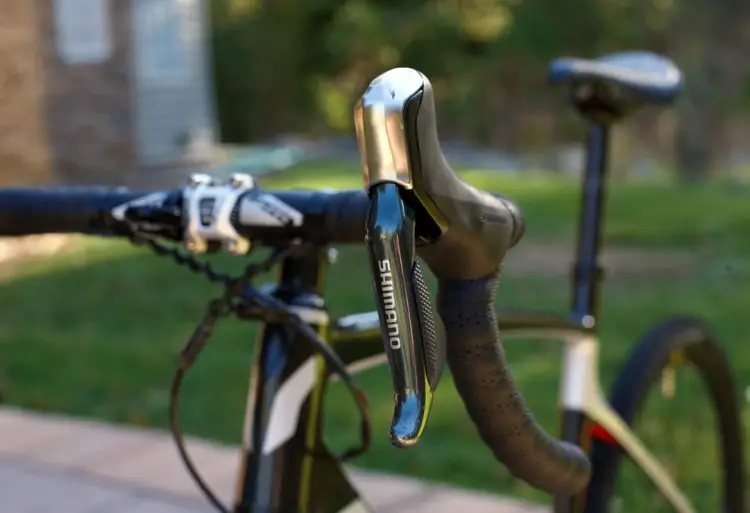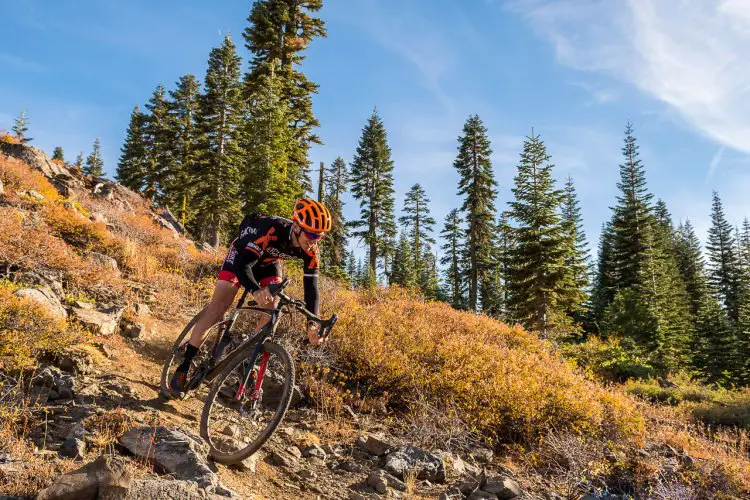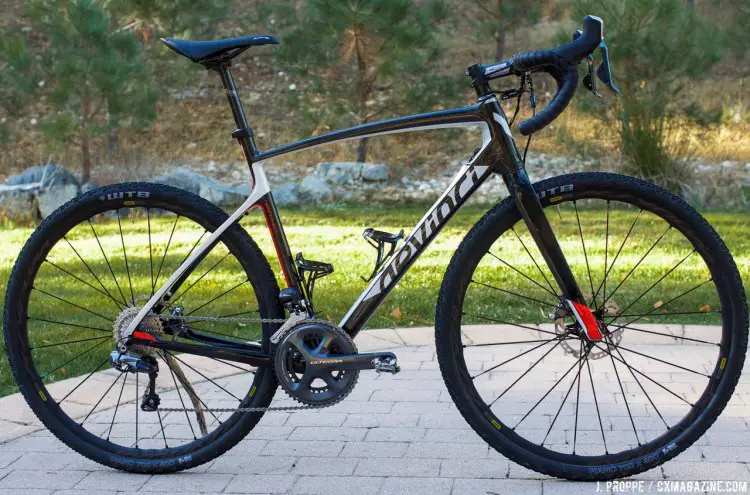Studio photos and spec sheets are nice, but Devinci, a Canadian brand with a long history of race-winning road and mountain bikes, wanted to prove the mettle of their newly-launched all-road bike, the Hatchet Carbon.
Devinci flew Cyclocross Magazine’s tester John Proppe out to Quincy, CA to shake down the Hatchet Carbon and race in Giro’s Grinduro. We gave the bike a baptism by fire with singletrack shuttle runs, and wide-open race action. Read on for how the Hatchet Carbon fared.
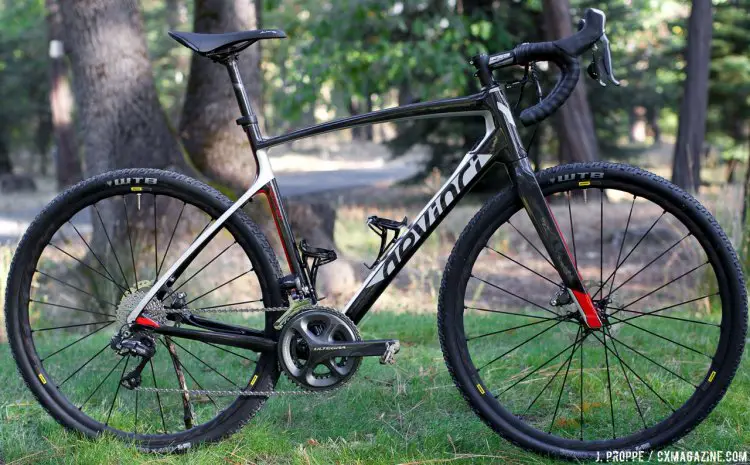
The Devinci Hatchet Carbon was our guide in the California Sierra, and is in shops now. 2017 Devinci Hatchet Carbon gravel bike. © Cyclocross Magazine
The Background
“A gravel race bike.” Devinci road product manager (and former World Tour roadie) David Veilleux minced no words about the intended purpose of the Hatchet Carbon. In development of the bike, Veilleux regaled us with tales of group rides and Strava segments on forest roads near Devinci’s Quebec-based headquarters.
The bike reflects this R&D, a stiff bike with a smart, albeit high-end, spec that holds no punches when it comes to performance.
For the utilitarian or the budget conscious, the Hatchet is available in aluminum, or a 105-equipped carbon build.
The Spec
Devinci provides the Hatchet Carbon with its Dual Core Fusion carbon—which utilizes a more compliant, lightweight layup for the top half of the bike, and a stiffer, more impact-resistant bottom half, which responds well to out of the saddle efforts and offers extra protection against rock strikes.
The Devinci Super Leggerra fork features a tapered carbon-fiber steerer, internal cable routing, disc brake flat mounts and a capped 12mm thru axle. The fork has hidden fender mounts and easily clears a 40mm WTB Nano. While Devinci officially recommends a max tire width of 40mm, those in drier climates should be able to fit something like a 45mm WTB Riddler with little to no problem.
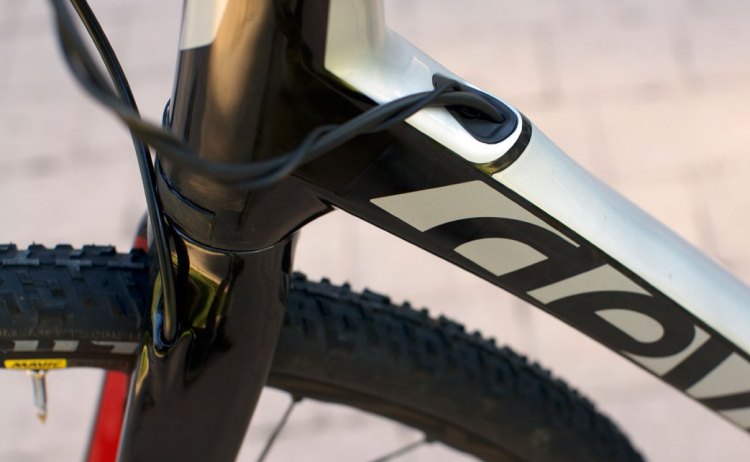
Devinci calls its internal cable routing entrance an “intake port.” The Hatchet Carbon ships with six different port plugs. Mechanical, electronic or a dropper, the Hatchet has you covered. © Cyclocross Magazine
The shaped down tube features an “intake port”, for which Devinci ships the bike with six different covers. Mechanical or electronic shifting, hydro hoses or cable-actuated brakes or even a stealth dropper, if you can spec it, the Hatchet Carbon will accommodate it.
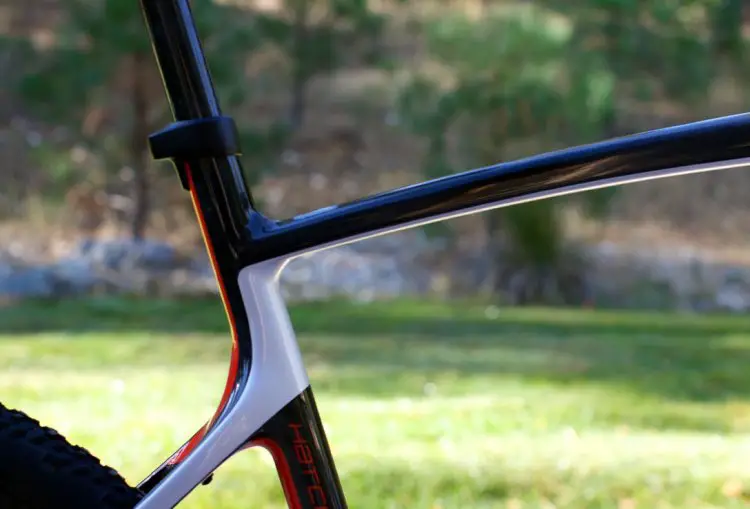
The shaped top tube of the Hatchet Carbon is portage-ready, and the dropped seatstays are engineered to provide bump compliance while seated. © Cyclocross Magazine
The shaped top tube is shoulder friendly, and Devinci has dropped the bottle bosses. The lower bottle bosses offer three-fold advantage: increased room for a frame bag, ability to shoulder the bike with two cages and bottles and a lower center of gravity.
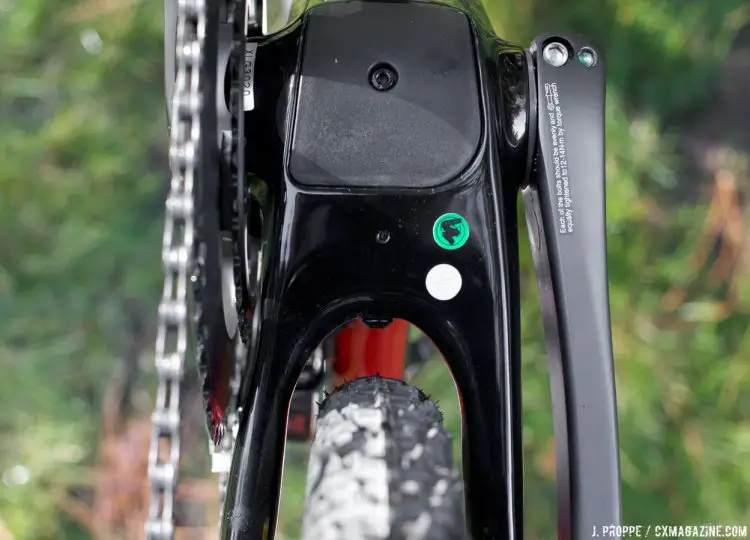
The Hatchet Carbon fits 40mm WTB Nano tires with room to spare, and offers easy access to route wires or cables. There’s no mud shelf should you find yourself in sloppy cyclocross or gravel conditions. 2017 Devinci Hatchet Carbon gravel bike. © Cyclocross Magazine
Dropped and highly-shaped seatstays, paired with the Dual Core Fusion carbon on the Hatchet offer a smooth ride when the terrain turns choppy. The BB86 bottom bracket keeps the bike torsionally stiff when you give it the beans, and provides ample tire clearance. As with the front, a 40mm Nano clears with room to spare.
Out back, the Hatchet Carbon features flat mount disc brakes, hidden fender mounts and a 142×12 thru axle.
I rode an Ultegra DI2 hydraulic disc brake spec’d bike with an Ultegra 6800 compact crankset that retails for $5749 USD, and as it goes, the group was problem free. The Ice-Tech rotors were a welcome add-on for some of Grinduro’s longer descents. The brakes got a little loud, but no brake fade occurred. There was a bit of chainstay slap with the Ultegra 6870 rear derailleur, along with a dropped train on some brake bumps, but unless you are an intrepid DIYer, or Molly Cameron, that’s par for the course with the spec.
One complaint–while personal to the flatland-living and 10-pound-overweight reviewer–was that the 50/34 chain rings and 11/32 cassette left me offering my kingdom for one easier gear on Grinduro’s steeper climbs. If you want to install a larger cassette, you’ll need something like the Wolf Tooth Components Roadlink, as Shimano’s spec for the 6870 rear derailleur has it maxing out at 32 teeth.
A Fizik Aliante saddle mounted on a 27.2 Devinci-branded carbon seatpost to soak up any road chatter. FSA Adventure bars feature a 12 degree sweep to keep your forearms clear while in the drops and give you a little extra room if you’d like to run a handlebar bag.
For our review ride, Mavic Kyrsium Pro Disc All Road wheels had 40mm WTB Nano 40c tires mounted tubeless. The 19mm width of the All Roads allow you to easily run a 28mm road tire. The factory spec of the Hatchet Carbon has Maxxis Refuse slicks front and rear, but for our singletrack-heavy riding, something with a little bit more bite was perfect.
The Ride
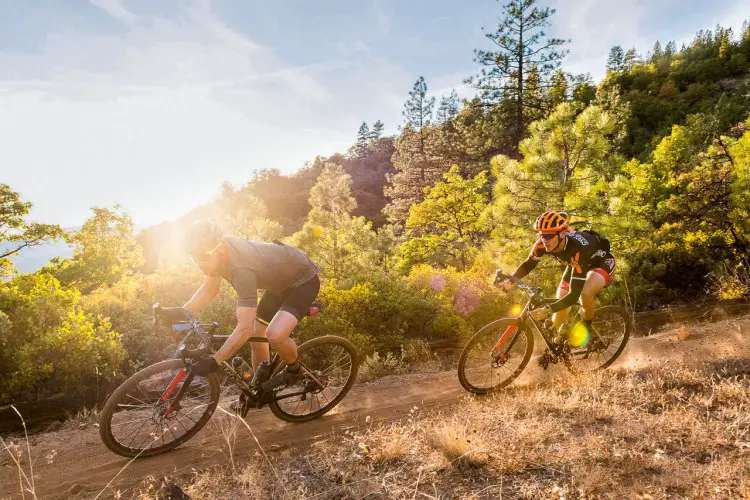
Devnici’s road product manager leads your reviewer on the best the Plumas National Forest has to offer. © Colin Meagher
The Hatchet Carbon rips.
With early-week shuttles provided by Yuba Expeditions, and a worthy guide, I experienced uninterrupted descending off of Mount Hough, losing nearly 4,000 feet of vertical.
With a 71 degree head angle, and slightly longer top tube (57.5cm on our size large) paired with a 10mm shorter stem than my usual fit, Devinci’s mountain bike design experience was apparent any time the bike pointed downhill. A 70mm bottom bracket drop and longer wheelbase than your average cross bike (105.6 cm on size large) led to a predictable ride at the expense of snappy accelerations. 43.5cm chainstays kept the Hatchet Carbon steady and predictable at high speeds, but gave up a little when it came to picking up the front end. Could you race cyclocross on it? Sure, and it’s got great mud clearance, but the company has optimized the design for longer days in the saddle, and less hairpin turns.
The Dual Core Fusion and shaped tubes, along with the 40mm WTB Nano TCS tires helped to take the edge off of some downhill chatter. With that being said, the Hatchet Carbon is a race bike, if you’re looking for something for all-day gravel rides, you may want to look elsewhere.
Front and rear thru axles, and ample tire clearance meant no rub, either by the tires or the disc rotors, no matter how hard I pushed the bike into berms or g-outs.
When the road turned uphill, the Hatchet Carbon’s weight was apparent. A middle-of the road parts spec, combined with the beefy Dual Core Fusion down tube and chainstays gives you a stiff and durable, but not feather-weight, bike. A size medium Hatchet Carbon comes in at a claimed 19.18 lbs; weight weenies need not apply.
All and all, I came out of the weekend impressed by how well the Hatchet Carbon held up to the rigors of Grinduro and riding in the Lost Sierra. In a race that many people consider riding mountain bikes (but ‘cross bikes won on the day), the amount of abuse the Hatchet Carbon took with no real hiccups left me impressed.
If you want a durable bike to shred singletrack and top your local Strava leaderboards, give the Hatchet Carbon a closer look.
Devinci Hatchet Carbon Full Specs
Frame: Devinci Hatchet Carbon
Fork: Devinci Super Leggera Carbon
Shifters: Shimano Ultegra 6870 Di2
Crankset: Shimano Ultegra 6800 50/34 Chainrings
Brakes: Shimano RS785 hydraulic disc, flat mount. Ice-Tech RT-86 Rotors: 160mm front, 160mm rear
Cockpit: FSA Adventure alloy handlebar, FSA Gossamer alloy stem
Seatpost: Devinci Elite Carbon 27.2mm with DI2 battery
Saddle: Fizik Aliante R5
Wheels: Mavic Ksyrium Elite Disc Allroad
Tires: As reviewed: WTB Nano 40mm. As spec’ed: Maxxis Refuse 40mm
MSRP: $5749 as tested. $3099 carbon 105 model and $3699 Ultegra mechanical models are also available.
More Info: Devinci.com
2017 Devinci Hatchet Carbon Ultegra Di2 Open Road Bike Photo Gallery:













